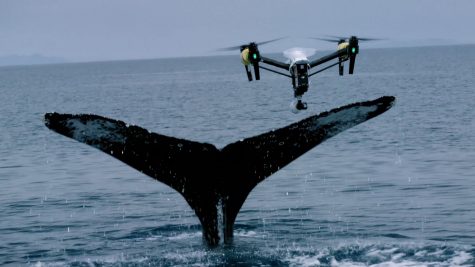The Snot Bot
January 9, 2017
Every year thousands of whales are hunted and killed due to human curiosity and other ocean occurrences. Whales are injured or killed usually by large ships, fishing nets, and whalers; the population of whales is slowly decreasing due to these reasons. We need better technology to understand human impact on whales and their habitats and also tools that would no longer harm or harass them. Researchers in Alaska use to gather whale’s DNA and other information with harpoons, but now without harming the whales all they need to do is capture their spray when they come up for air. The CEO and scientist at Ocean Alliance, Dr. Iain Kerr in Gloucester, invented a device called Snot Bot. A Snot Bot is a flying drone with a petri dish attached which is designed to help track whales. Kerr told CBS that the main goal of this project was to be able to collect data without stressing the whales.
When Iain Kerr needed help solving this problem, and was on a tight budget, he looked for help from Ipswich High School’s very own Robotics team. The Snobot team consisted of Roman Gadbois, Peyton Fitzgerald, Annabelle Platt, Filip Kernan, Lily Acevedo, and George Gallagher. It was supervised by two parents, Mr. Gadbois and Mr. Platt. The students challenge was to help Iain Kerr figure out how to maintain a specific height during the flight of the drone; it’s important for the drones to stay a certain height above the water so that they do not disturb, stress, or harm the whales. The team got the opportunity to work on this project throughout the summer and they eventually came up with a helpful solution. Ipswich’s very own Mr. Costa, the robotics teacher, said “The kids spent hundreds of hours working on this program.” After a while of failed attempts and designs they figured out a laser beam system that bounces off the water and transmits the drone’s position above the whales. After the team was able to figure out the measurement above the water, they next needed to figure out how to send the measurements to the pilot. Their solution was to use radio controlled microcontroller boards to send the measurements wirelessly. A sound board was added that listened to the microcontroller and converted the height measurements to audio for the person controlling the drone.
In order for the electronics to withstand the outside environment, the students had to package it all together by using a 3D printer to create the cases. The end result was that the drone could communicate its height and altitude above the ocean audibly to the pilot through an earpiece. The snot bot is able to get cells from inside the whale’s lungs when the drone flies over the whale and captures the so called “snot” (spray) from their spouts. Scientists can then examine the DNA and other things closely. The students were able to take the skills they were learning and apply it to a real life situation; they were able to solve a real-life problem for the Ocean Alliance. Senior Roman Gabios, who specialized on electronics said “we’ve shown a new way of how drones can be used.” The students have brought a new perspective of how to use drones and how they can be designed to help real world problems. Additional team members that worked on the project were Kendra Williams, Pat Mattin and George Gallagher. These Ipswich High School students were able to use their knowledge and apply it to a case that will make a big difference in science and the safety of whales.  DJI Stories
DJI Stories
